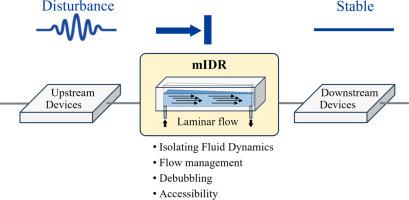一个通用的微流控中间输送储层隔离流体动力学在串行互联的微流控网络
IF 6.3
3区 工程技术
Q1 ENGINEERING, CHEMICAL
Journal of the Taiwan Institute of Chemical Engineers
Pub Date : 2025-09-09
DOI:10.1016/j.jtice.2025.106389
引用次数: 0
摘要
串行互连的微流控设备使先进的应用,如多步骤化学处理和多器官芯片系统。然而,由于连接通道中相互依赖的流体动力学,管理这些系统带来了挑战,即使很小的干扰也会在整个网络中传播,影响整个系统的性能。本研究介绍了一种基于微流体的中间输送储层(mIDR),旨在解耦串行连接设备之间的流动相互依赖性,同时保留基本的微流体特征,如一致的液体停留时间。当与气动泵集成时,mIDR能够精确的液体压力调节和独立控制进口和出口流量。其楔形开槽结构产生毛细力梯度,提高液体传递效率。使用时间敏感酶促反应的实验验证证实了其维持层流特性、隔离串扰和稳定互联微流体装置运行的能力。重要发现:mIDR的开放通道设计扩展了其多功能性,允许附加功能,如去泡和直接访问,结合了开放和封闭微流体系统的优点。这项创新为控制复杂微流体网络中的流体动力学提供了强大而灵活的解决方案,为多步骤(生物)化学过程提供了更高的可靠性和效率。本文章由计算机程序翻译,如有差异,请以英文原文为准。

A versatile microfluidic intermediate delivery reservoir for isolating fluid dynamics in serially interconnected microfluidic networks
Background
Serially interconnected microfluidic devices enable advanced applications such as multi-step chemical processing and multi-organ-on-chip systems. However, managing these systems presents challenges due to interdependent fluid dynamics in their connecting channels, where even minor disturbances can propagate throughout the network, affecting overall system performance.
Methods
This study introduces a microfluidic-based intermediate delivery reservoir (mIDR) designed to decouple flow interdependencies between serially connected devices while preserving essential microfluidic features, such as consistent liquid residence time. When integrated with a pneumatic pump, the mIDR enables precise liquid pressure regulation and independent control of both inlet and outlet flow rates. Its wedge-shaped open-channel structure generates capillary force gradients, enhancing liquid transfer efficiency. Experimental validation using time-sensitive enzymatic reactions confirms its ability to maintain laminar flow characteristics, isolate crosstalk, and stabilize interconnected microfluidic device operation.
Significant findings
The open-channel design of the mIDR expands its versatility, allowing for additional functionalities such as debubbling and direct accessibility, which combine the advantages of both open and closed microfluidic systems. This innovation provides a robust and flexible solution for controlling fluid dynamics in complex microfluidic networks, offering improved reliability and efficiency for multi-step (bio)chemical processes.
求助全文
通过发布文献求助,成功后即可免费获取论文全文。
去求助
来源期刊
CiteScore
9.10
自引率
14.00%
发文量
362
审稿时长
35 days
期刊介绍:
Journal of the Taiwan Institute of Chemical Engineers (formerly known as Journal of the Chinese Institute of Chemical Engineers) publishes original works, from fundamental principles to practical applications, in the broad field of chemical engineering with special focus on three aspects: Chemical and Biomolecular Science and Technology, Energy and Environmental Science and Technology, and Materials Science and Technology. Authors should choose for their manuscript an appropriate aspect section and a few related classifications when submitting to the journal online.

 求助内容:
求助内容: 应助结果提醒方式:
应助结果提醒方式:


